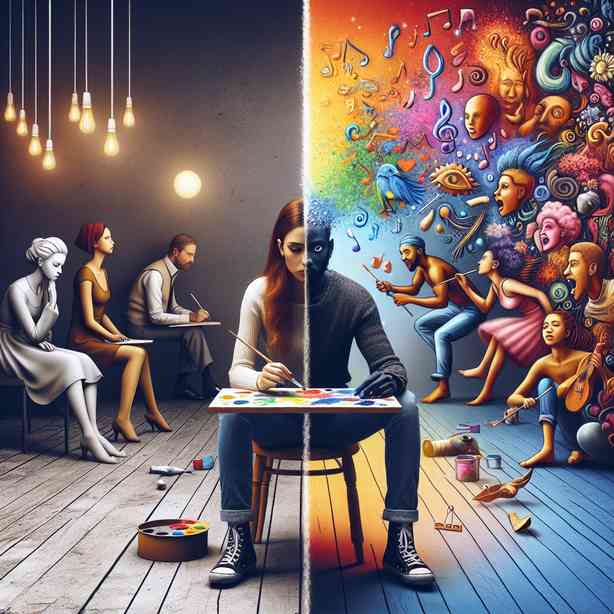
Art has always been a multifaceted mode of expression, and the act of painting encapsulates an intricate dance between the artist and the canvas. The idea of painting in silence invokes a sense of solitude and introspection; however, many artists and art enthusiasts alike contend that silence is not the ideal backdrop for this creative endeavor. The very essence of painting is imbued with emotion, and often, it is the sounds of the world around us that enrich this experience and inspire creativity.
When we consider the relationship between sound and painting, it becomes essential to acknowledge the role of sensory stimulation in the creative process. Different sounds can evoke vivid memories, emotions, and inspirations that inform and direct an artist’s brush. For instance, the gentle rustling of leaves, the rhythmic sound of raindrops, or even the distant chatter of people can all provide a backdrop that helps artists dive deeper into their work. These elements feed the mind, stimulating thoughts and feelings that might not emerge in complete silence.
Moreover, our environment plays a crucial role in influencing our emotional states, which in turn can significantly affect a painting’s outcome. A bustling café, with its myriad of conversations and clinking cups, may ignite a sense of warmth and community, inspiring an artist to capture those feelings on their canvas. Conversely, the sound of serene ocean waves could evoke tranquility and introspection, guiding the artist to create a work that embodies those peaceful emotions. The sounds we encounter can often serve as catalysts for our artistic expression, urging us to explore diverse themes and subjects.
The creative process is inherently social as well. Throughout history, many artists have thrived in collaborative environments. The presence of others can lead to the exchange of ideas, constructive critiques, and a vibrant exchange of energy that can be incredibly stimulating. For example, art studios often buzz with the conversations and laughter of like-minded individuals focused on pushing each other toward greater heights. This community interaction fosters a sense of belonging, encouraging artists to take risks, explore new techniques, and ultimately grow in their craft.
In contrast, painting in silence might lead to an isolating experience. While solitude can be beneficial for reflection and focus, excessive silence may inhibit creativity for some individuals. It could lead to an internal dialogue that stifles ambition, making it challenging for artists to engage fully with their work. The absence of sound can create a void that may amplify self-doubt and fear of imperfection, whereas the presence of sound can remind artists of the beauty of imperfection and the organic flow of inspiration.
Additionally, different genres of art may naturally gravitate toward specific soundscapes. Abstract painters might find themselves at home with ambient or instrumental music, which allows them to explore their innermost thoughts without the distraction of lyrics. Conversely, more narrative-driven artists may prefer vocal music or soundscapes that tell a story, providing a thematic undertone to guide their brushstrokes. Each genre can evoke different feelings and responses, further emphasizing the importance of sound in the creative process.
Furthermore, the emotional responses triggered by music or external sounds can deepen the artist’s connection to their work. For instance, an upbeat tempo might energize an artist, urging them to create a vibrant and lively painting, while a melancholic melody could induce a more somber atmosphere, leading to darker color choices on the canvas. The collaboration between sound and visual art showcases a unique interaction where one medium amplifies the resonance of the other, creating a richer experience for both the artist and the viewer.
It is not solely about the music or background noise itself but how an artist relates to those sounds. Some may thrive under the hum of a bustling environment, drawing inspiration from life’s constant motion, while others may require soothing melodies for a more introspective journey. Understanding oneself as an artist and recognizing how sound impacts your creative flow is crucial in harnessing the unique energy that influences your art.
Furthermore, various cultures around the world have recognized the importance of music and sound in the creative process for centuries. Traditional practices often incorporate sound as an integral aspect of art-making, whether it be singing, drumming, or using specific instruments to set the tone for artistic expression. This deep-rooted connection signifies just how powerful sound is in contributing to creativity, bridging gaps between generations and artistic styles.
On a more practical level, engaging with sounds can elevate one’s painting experience to an almost meditative state. The rhythmic brushstrokes, combined with the right ambient sound, can transport the artist into a flow state, where they become fully immersed in the act of creation. In this state, time seems to dissolve, and the artist can access a deeper level of creativity, resulting in works that resonate not only personally but also universally with those who view them.
As we explore the reasons why silence may not be the ideal environment for painting, it becomes evident that sounds in our surroundings play a critical role in our emotional and psychological states. They can help ground us, inspire us, and ultimately guide our artistic expressions. The dynamic relationship between sound and painting is one that deserves attention and appreciation, as it nurtures and shapes our creativity in profound ways.
In conclusion, while silence may have its merits, the act of painting flourishes in environments that stimulate the senses. Embracing sound as a vital part of the artistic process can lead to richer, more expressive works that resonate with both the artist and the audience. Whether through the gentle whisper of nature, the bustling energy of a crowd, or the evocative notes of music, these elements serve to enhance our painting experiences, inviting us into a world where creativity knows no bounds. Embracing sound not only opens doors to inspiration but also enhances the overall artistic journey, making it an essential element in the beautiful act of painting.


